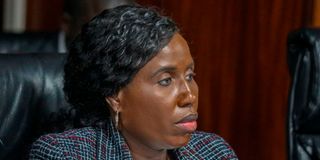Premium
Government cancels planned university fee hike after public outcry

The Ministry of Education has cancelled the previously announced university fees for new students, stating that respective universities will now announce new fees to be paid by each student as a household contribution.
What you need to know:
- Kicker: This will come as a relief to parents who have been crying foul over the high cost of university fees.
- Quote: "The funding model is a pain for students and parents. It only favours the rich." – National Assembly Minority Leader Opiyo Wandayi.
The Ministry of Education has cancelled the announced tuition fees for students who sat the 2023 Kenya Certificate of Secondary Education (KCSE) examination and were placed in various courses.
This will come as a great relief to parents who have been crying foul over the high cost of university fees. This means that the government will announce a new university fee structure.
In a statement to newsrooms, Beatrice Inyangala, the Principal Secretary for Higher Education, announced the scrapping of university fees for first-year students placed in university institutions by the Kenya Universities and Colleges Central Placement Service (KUCCPS).
Dr Inyangala said that from August 5, 2024, the respective universities will communicate the new fees to be paid by each student as a household contribution.
“The Ministry of Education wishes to inform the public, particularly parents/guardians of students, and, students that the fees to be paid by students and their families/guardians as relates to the full cost of each degree programme as previously communicated in the admission letters is hereby nullified, and, does not apply anymore,” said the PS.

State Department for Higher Education and Research PS Beatrice Inyangala when she appeared before the National Assembly Committee on Education on June 4, 2024.
Respective universities
The PS said that the Ministry of Education has already informed the students through the respective universities.
“It is also important for the students and their parents/guardians to note that their placement in the respective academic programmes remains unchanged. We wish to confirm that their places in the academic programmes are firmly secured,” said Inyangala.
On May 31, 2023, President Ruto launched the Higher Education Funding Model, which was implemented in September of the same year for all first-year students in a bid to fix the financial health of universities.
The model was introduced due to the financial difficulties faced by higher education institutions, which were owed over Sh60 billion. Under the scheme, beneficiaries are given loans, bursaries or both, and students are categorised into five bands according to their families' level of need.
The categorisation of students has been achieved through a reliable scientific method, the Means Testing Instrument (MTI), which is used to determine the level of financial need of students to ensure that they receive adequate support.
Government support is provided through scholarships awarded by the Universities Fund (UF) and student loans awarded by the Higher Education Loans Board (Helb). While students do not have to repay the bursary component, the tuition and maintenance loans are payable on graduation and carry an interest rate of four per cent per annum.
Under the old model, graduates only paid for the maintenance loan and the bursary (grant) was automatic for all government-supported students.
For example, a Band 1 (most needy) student studying medicine at a total cost of Sh520,000 per year will receive a grant of Sh364,000 (70 per cent of the total), a tuition loan of Sh130,000 (25 per cent) and a maintenance loan of Sh60,000 per year.
Pay the balance
The student's household is expected to pay the balance of Sh26,000 per year.
In six years, the student's total loan will be Sh1,140,000, while those under the old model who receive the maximum maintenance loan will only have to repay Sh360,000 to the government.
The tuition fees for a Bachelor of Arts degree are the cheapest of all the universities with the lowest being Sh144,000. A Band 1 student qualifies for a scholarship of Sh100,800 and a tuition loan of Sh36,000 per year. Such a student will also qualify for a maximum maintenance loan of Sh60,000. At the end of the four-year course, the debt owed to the government will be Sh384,000, compared to Sh240,000 under the old model.
However, the model appears to have pushed more students out of public universities and into private ones, according to placement data released by the Kenya Universities and Colleges Central Placement Service (Kuccps).
More than 18,000 students opted to be placed in private universities, up from 9,000 last year. In total, the service placed 153,274 students in various universities this year.
Students entering universities and colleges from August are currently applying for funding, with results expected from July 31, 2024. Students will then know how much they will have to pay for tuition fees, taking into account government support.
This comes barely weeks after the opposition wing called on President William Ruto to scrap the new higher education funding model, saying it was a pain for students and parents.
Model only favours the rich
Through National Assembly Minority Leader Opiyo Wandayi, the opposition said the funding model only favours the rich.
Wandayi urged the state to revert to the old model of Differentiated Unit Cost (DUC), which was previously used to fund universities.
“Categorisation people is a complex matter. We have no proper mechanism to arrive at a proper objective classification or categorisation. This ends up disadvantaging those who are poor and most needy. And you know the corruption we have in the system. The whole thing should be reviewed,” the MP insisted.
In an interview with the Nation in Mombasa, the minority leader said the state should ensure that there is equity and fairness in funding students seeking higher education.
“The new higher education funding model has not achieved anything. In fact, it has made things worse,” Wandayi said.
Last month, Higher Education Principal Secretary Beatrice Inyangala told the National Assembly's Education Committee that the National Treasury had failed to remit Sh29 billion to both UF and Helb.
This included Sh7.9 billion for bursaries for first-year students under the funding model and Sh4.2 billion for bursaries for technical and vocational education and training (Tvet) students.
A further Sh6.7 billion had not been released to Helb for students in both universities and Tvet institutions under the old and new models.





